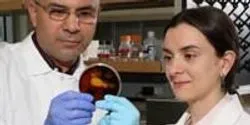Bacteria

Microbes are not only a rich source of disease, but also a rich source of medicines, and experts think many life-saving compounds produced by as-yet-unnamed bacteria are awaiting discovery. But they don’t always give up their secrets easily. Researchers must know where to look to find promising bacteria, and how to get them to grow in the lab, the traditional route to identifying potentially valuable molecules they produce.

Consumers may have more palatable low-fat products and milk producers a solution to an industrywide problem through use of a unique strain of lactic acid bacteria, according to Ashraf Hassan, associate professor of dairy science at South Dakota State University.

Corralling desperados with names like bacillus and paenibacillus will require ingenuity and an arsenal of weapons. These outlaws aren't rustling cattle—they're making milk sour and cheese soft and crumbly.

Buried deep in the mud along the banks of a remote salt lake near Yosemite National Park are colonies of bacteria with an unusual property: they breathe a toxic metal to survive. Researchers from the University of Georgia discovered the bacteria on a recent field expedition to Mono Lake in California, and their experiments with this unusual organism show that it may one day become a useful tool for industry and environmental protection.















